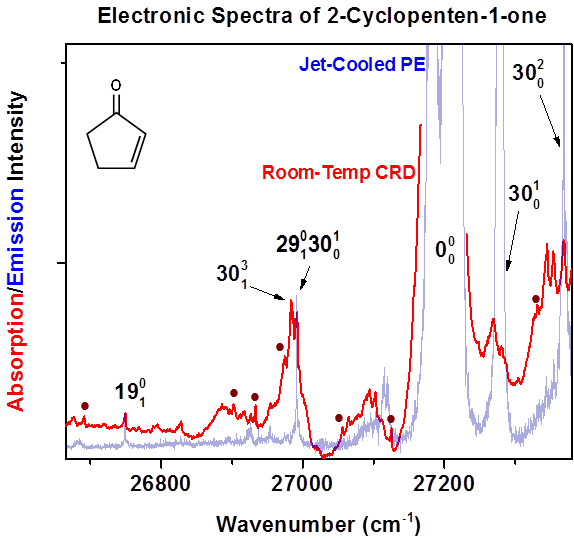Reports: UR654397-UR6: Spectroscopic Characterization of Acrolein in Its Lowest Triplet (n,pi*) State
Stephen Drucker, University of Wisconsin (Eau Claire)
Acrolein (CH2=CH–CH=O) is the smallest alpha,beta-unsaturated carbonyl molecule and serves as a prototype for investigating the photochemical properties of larger analogs. Much of this photochemistry is mediated by triplet excited species, including the T1(n,pi*) state. The goal of this project is to obtain experimental information about the structure and dynamics of acrolein in its T1(n,pi*) state. To accomplish this goal, we are planning to record the T1←S0 cavity ringdown spectrum of acrolein and deuterated isotopologues in a jet-cooled planar expansion. We will analyze the 0−0 band contours to obtain sets of inertial constants which will in turn establish the equilibrium geometry of the T1(n,pi*) state.
In the first year of the grant, the PI recruited two sophomore-level undergraduate students (one physics major and one chemistry major) who plan to participate in the project throughout the course of their degree programs. With support from the grant, the PI has engaged the students in a comprehensive training program covering the theory and practice of laser spectroscopy.
As a prelude to
the planned jet-cooled studies of acrolein, student
Michael McDonnell conducted a spectroscopic investigation of the
2-cyclopenten-1-one (2CP) molecule, a monocyclic enone
that has the same chomophore as acrolein.
The T1(n,pi*) vibronically resolved spectrum of 2CP is easier to analyze
than that of acrolein because of the conformational
rigidity imparted by 2CP ring structure. Previous work in our group utilized
cavity ringdown (CRD) and phosphorescence excitation
(PE) techniques to measure vibronically resolved T1
←S0 spectra of 2CP near the origin band. [ We conducted our
previous CRD study of 2CP using a bulk gas-phase sample at room temperature.
This yielded fundamental frequencies for the lowest-energy ring modes in the T1(n,pi*) state. We
supplemented that investigation by recording a jet-cooled PE spectrum, which
clarified room-temperature vibronic assignments and
extended the spectral coverage into the C=O and C=C stretch regions, about 1500
cm−1 above the T1←S0 origin.
However, the PE spectrum in this region did not afford new vibrational
assignments because the T1←S0 vibronic
bands become weak at higher frequency. The Franck-Condon factors for the C=O
and C=C stretch fundamentals are expected to be large, and so our inability to
detect these vibronic features are attributable to a
diminishing phosphorescence quantum yield at higher vibrational energies within
the T1←S0 band system. We carried out
our most recent work on 2CP in 2015 under support from the current PRF grant.
We recorded the room-temperature CRD spectrum of 2CP in the C=O / C=C stretch
region of the T1←S0 band system. We had not
surveyed this spectral region in our earlier CRD study of 2CP, because at the
time, the wavelength coverage of our dye laser system did not extend far enough
into the UV. Recently we built a second-harmonic generator that operates
synchronously with the scanning of the dye laser. This new system extends the
coverage of the dye laser into the UV by frequency-doubling the output of red
laser dyes. Figure 1 shows
the room-temperature CRD spectrum of 2CP we obtained under current PRF support.
Superimposed is the jet-cooled PE spectrum we measured previously. The spectral
region shown in Figure 1 is expected to contain the C=O and/or C=C stretch
fundamentals of the T1 state. These T1 vibronic levels are roughly isoenergetic
with the v=0 level of the S1 state. Thus the intense S1←S0
origin band, as well as nearby vibronic hot bands of
the S1←S0 system, interfere with T1←S0
vibronic features we wish to assign. Established S1←S0
assignments are indicated in Figure 1. The jet-cooled PE spectrum is much less
congested than the room-temperature CRD spectrum, so the interference from S1←S0
bands is less severe. Nonetheless, in this region of the PE spectrum, we do not
observe bands assignable to the T1←S0 system, presumably because of a diminished quantum
phosphorescence quantum yield, coupled with the nominal spin-forbiddenness of the T1←S0
transition. Figure 1: Cavity Ringdown
(red) and Phosphorescence Excitation (blue) spectra of 2-cyclopenten-1-one.
Assignments within the S1←S0 band system [Cheatham
and Laane, Because CRD is an
absorption-based technique, a low quantum yield for emission should not
significantly degrade the CRD intensity of T1←S0 vibronic features. Thus it is likely that the triplet-state
C=O and/or C=C fundamentals appear in the CRD spectrum of Figure 1, though
these transitions may be partially submerged by intense (spin-allowed) S1←S0
hot bands. The present CRD spectrum contains several features, not assigned in
previous work, that are likely T1←S0 vibronic bands, either fundamentals or attached sequences.
These features are marked with dark-red dots in Figure 1. In the upcoming
second year of the PRF grant, we will record the CRD spectrum of 2CP in the
same spectral region as shown in Figure 1, but under the cooling conditions of
a planar jet expansion. The jet cooling will suppress hot bands assigned to the
S1←S0 system and will reveal which of the
unassigned features marked in the figure belong to the T1←S0
system. In the process, we will be able to determine fundamental frequencies
for the C=O and/or C=C mode in the triplet state. These experimental values
will be compared to predictions available from high-level ab initio
computational methods. By completing this work on the 2CP molecule,
undergraduate student collaborators will acquire crucial experience in
operating our pulsed-nozzle molecular source in conjunction with the
acquisition of CRD spectra. They will also bring this final component of our
2CP project to the stage of publication. These activities will offer the
students excellent preparation for our planned studies of acrolein
described above.












